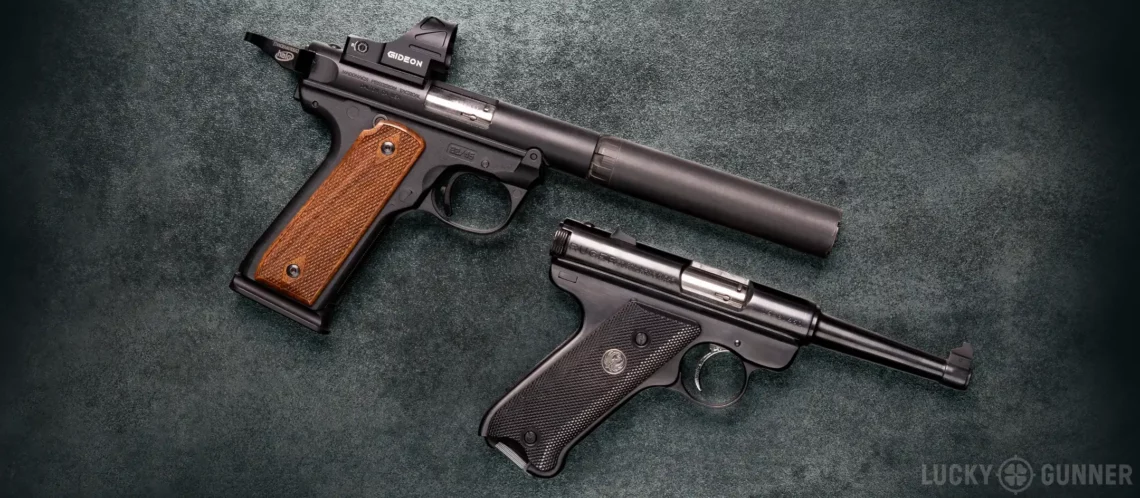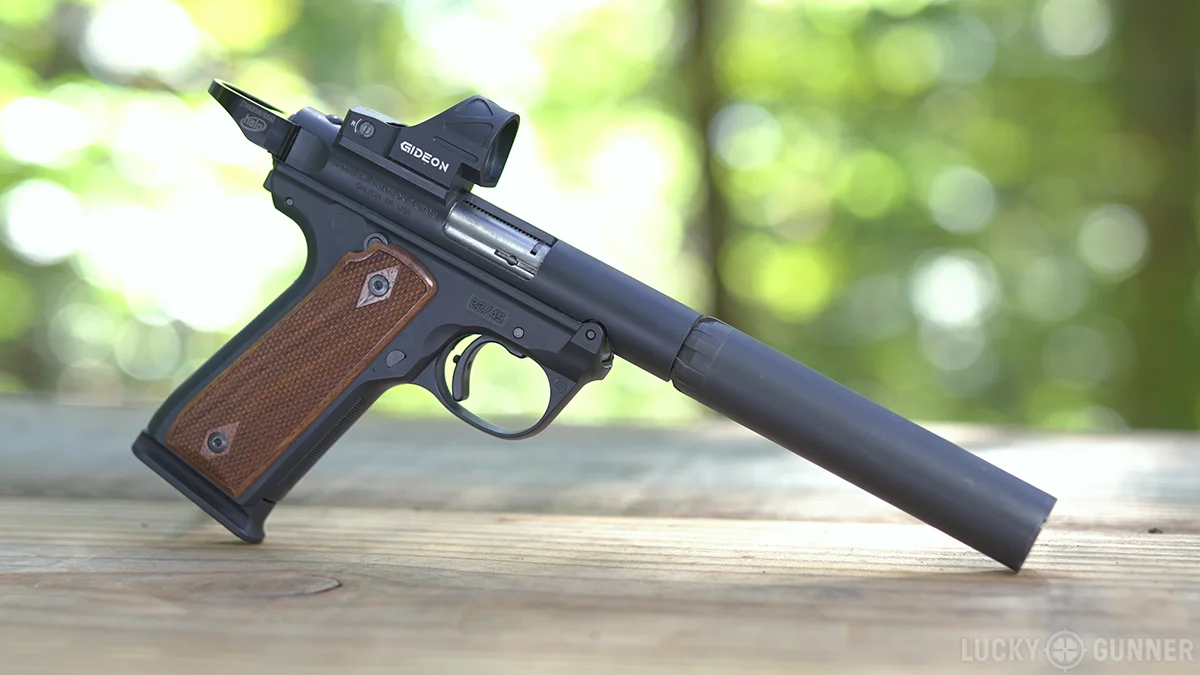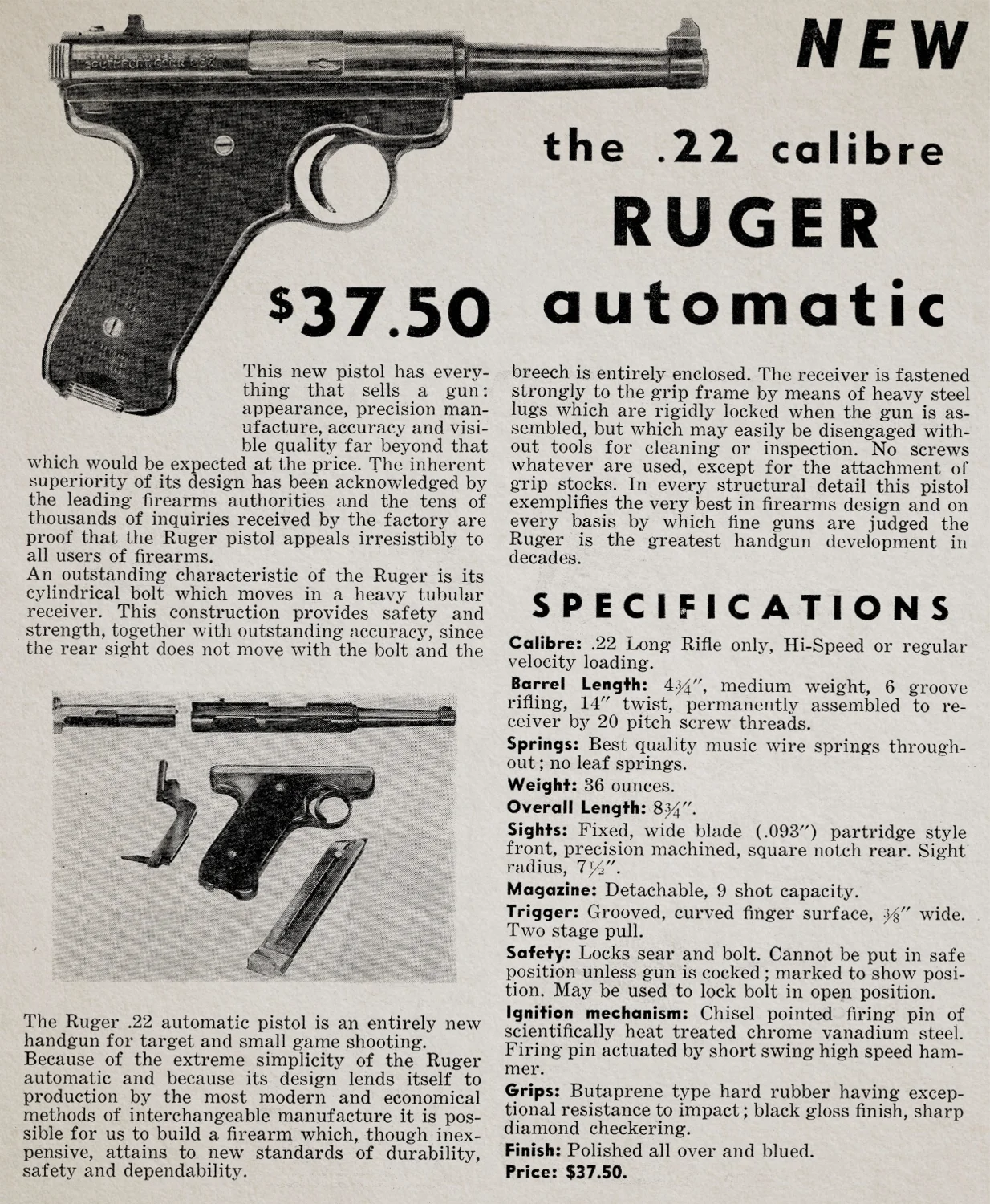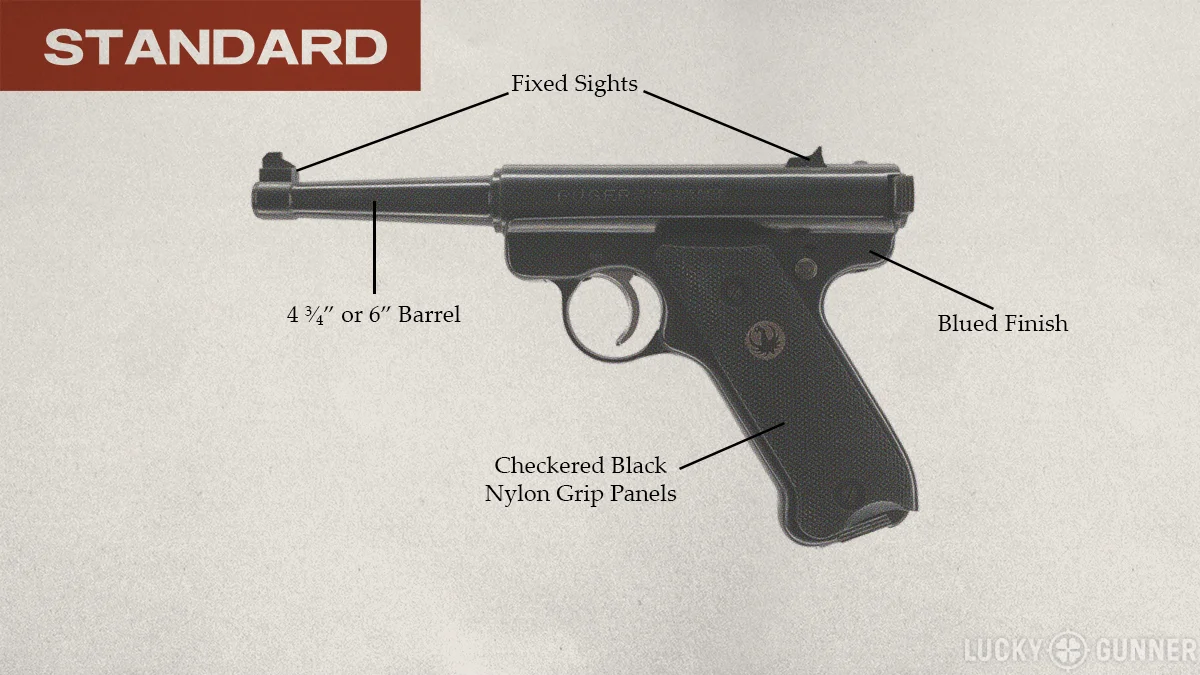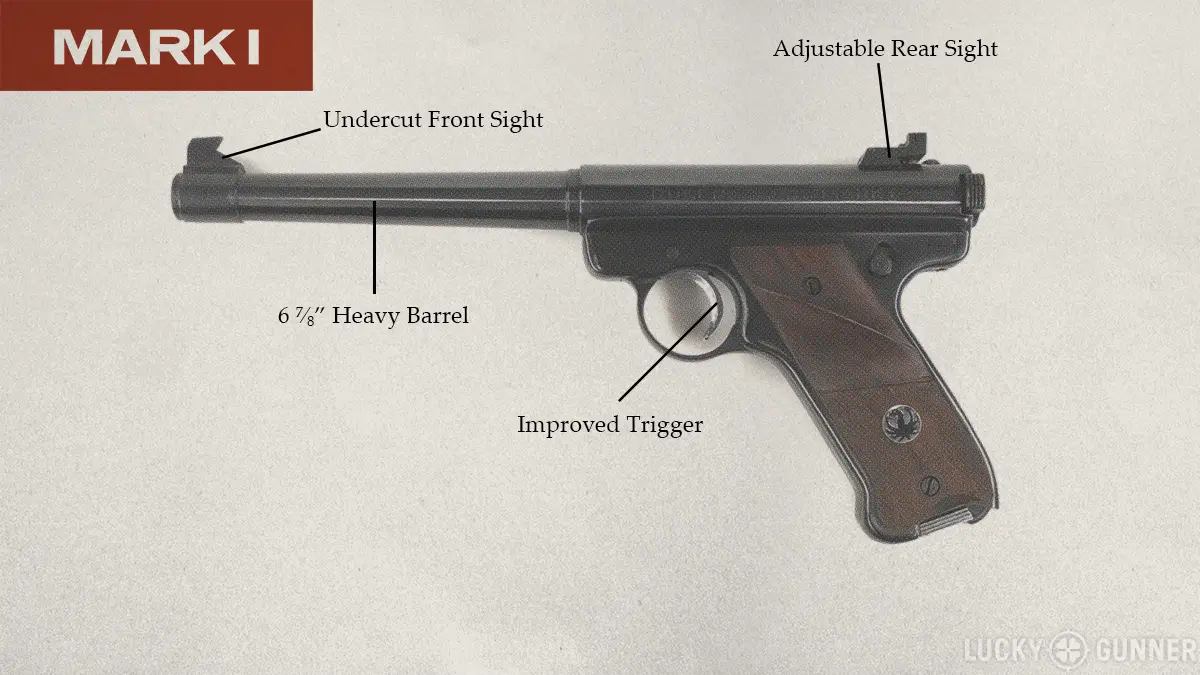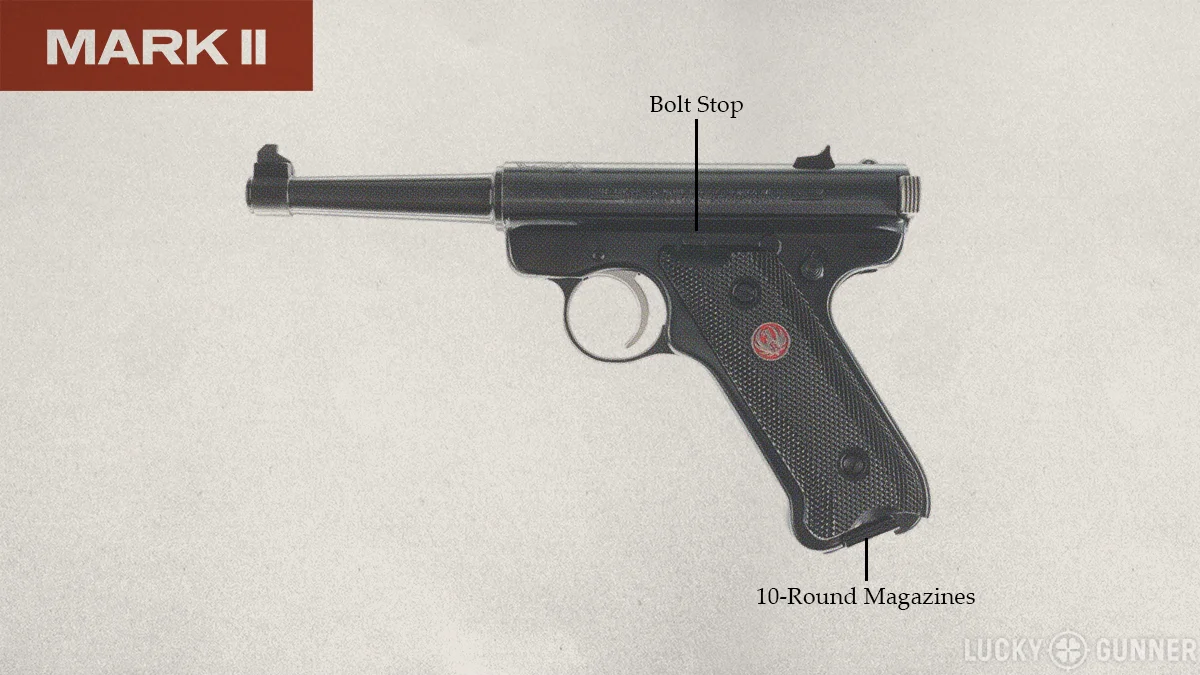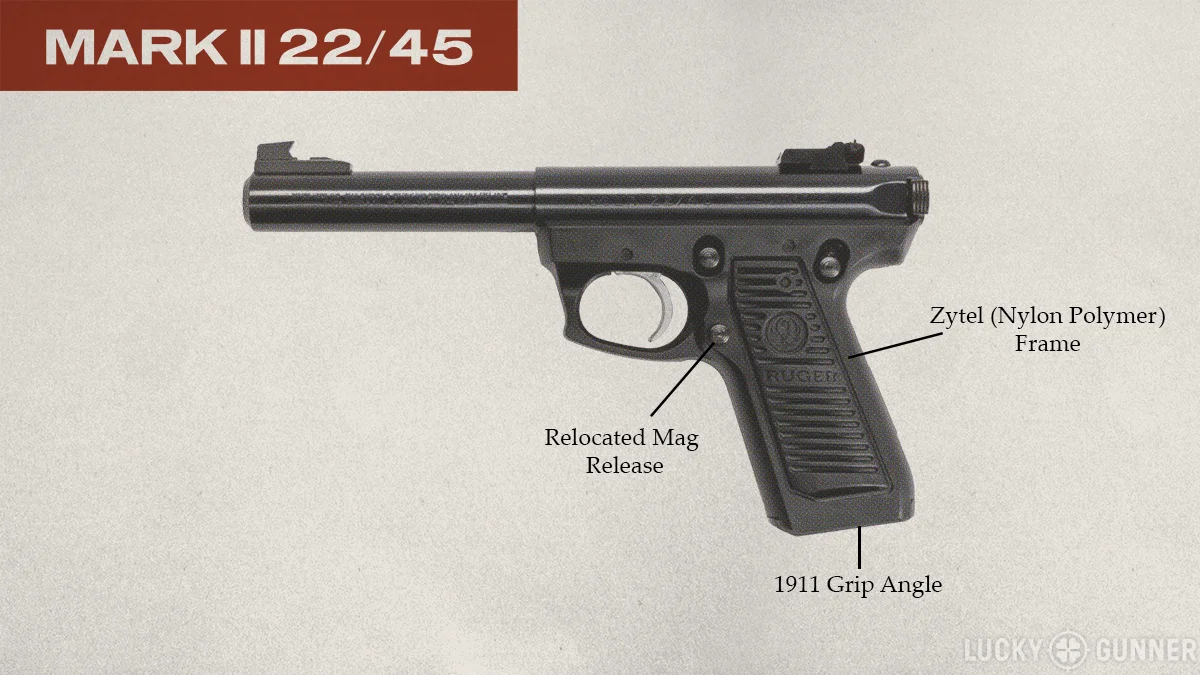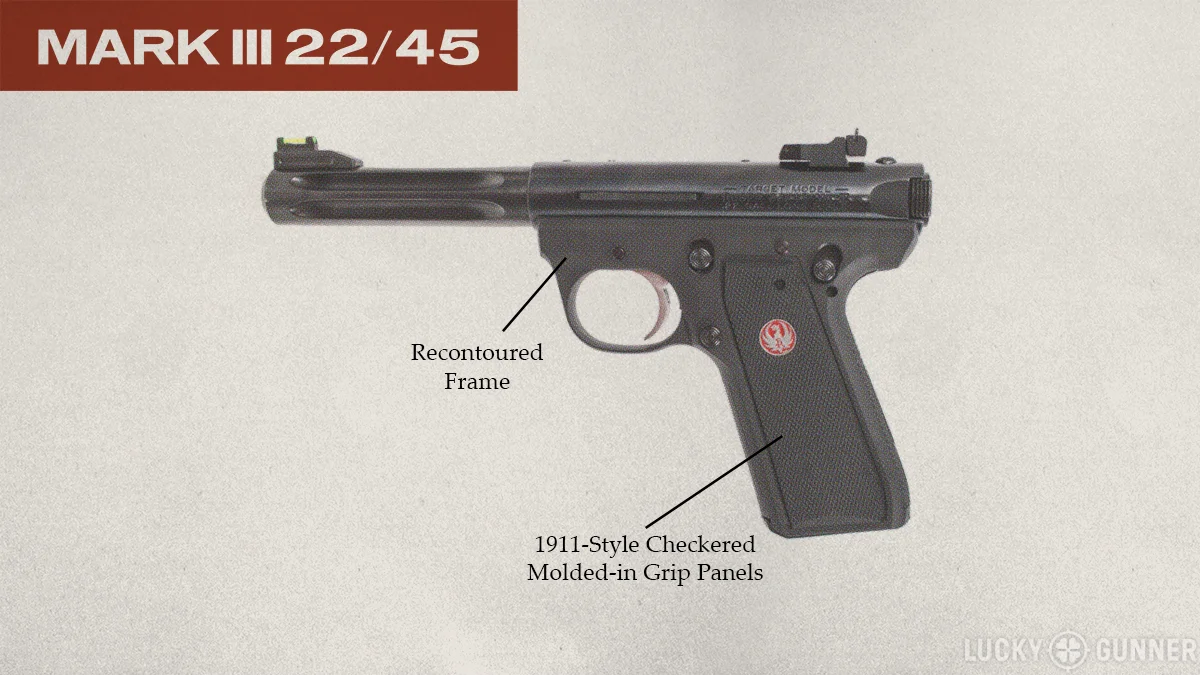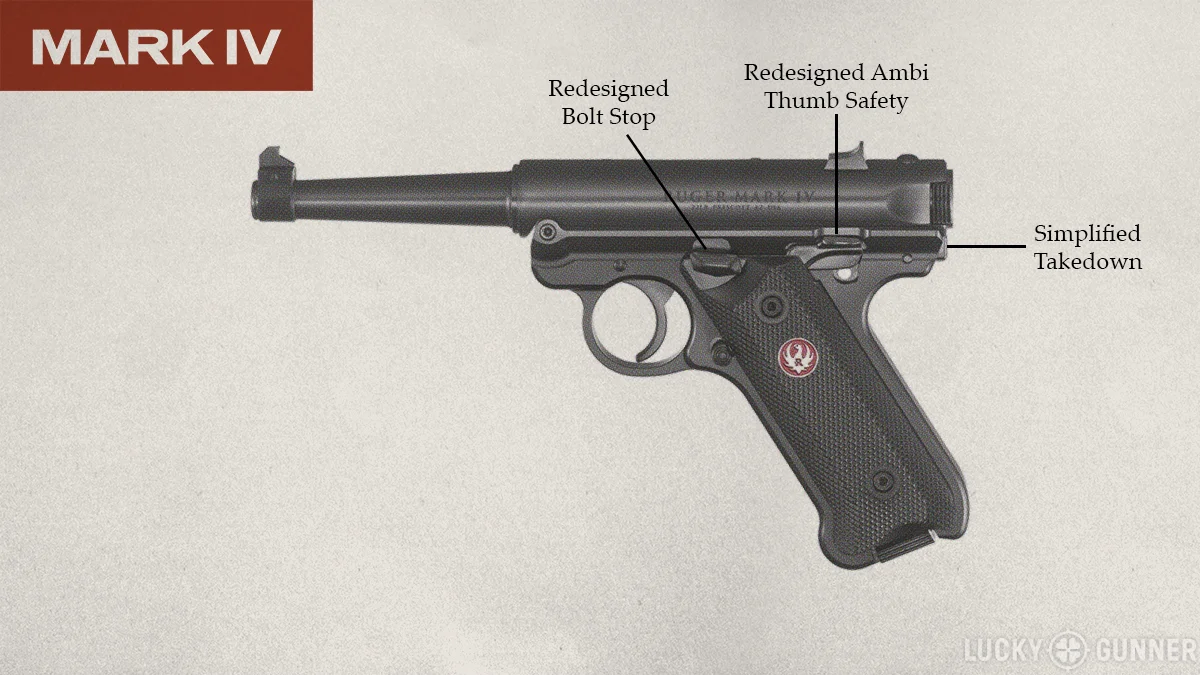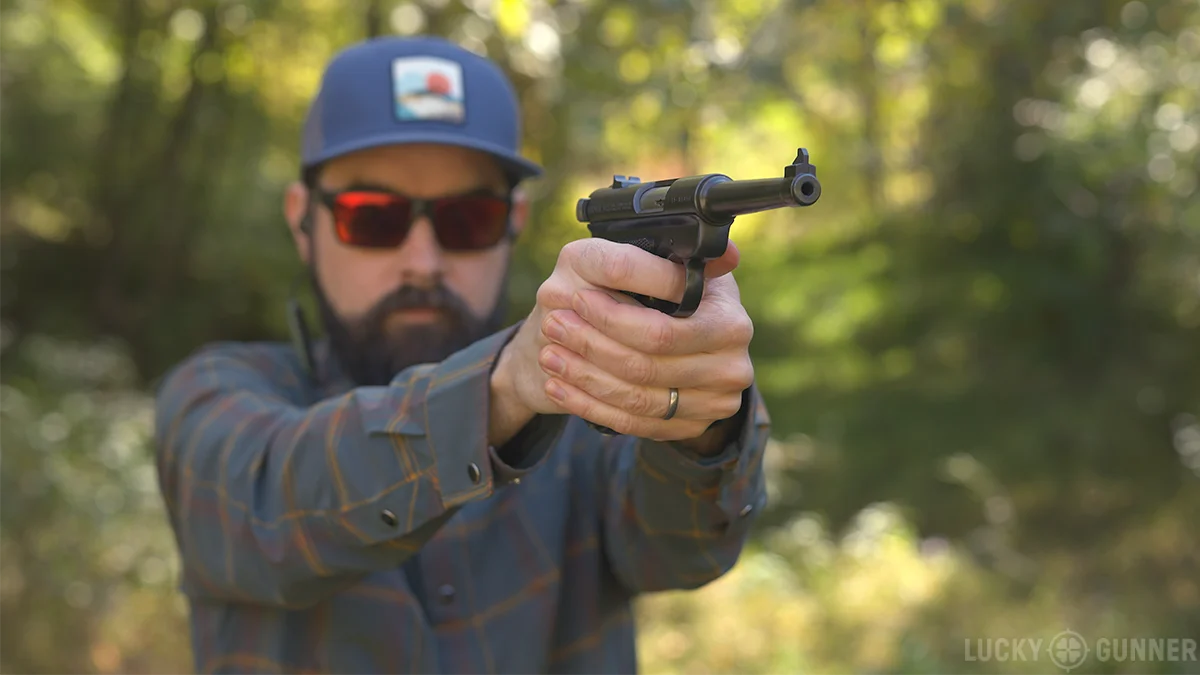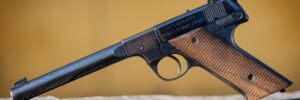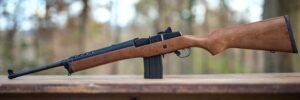We’re diving into the history and evolution of the Ruger Mark Series, the legendary .22 pistol that’s been dominating the rimfire pistol market for 75 years. From its humble beginnings in 1949 to the latest Mark IV models, we break down each generation of the Ruger Mark series and highlight the key features that make them stand out and discuss why its still a favorite among shooters today.
Details are in the video below, or scroll down to read the full transcript.
This is a Ruger Mark IV that I’ve set up to be the ultimate beginner-friendly pistol. The trick was finding an extra-short aftermarket barrel so that it wouldn’t feel front-heavy with a suppressor attached. It’s also got… well, it’s got a bunch of other stuff, but we’ll come back to that later.
Ruger’s .22s are well known for being highly customizable, but that’s not what put them on the map in the early days. When these guns first appeared on the market 75 years ago, no one had even heard the name “Ruger.”
A Gap in the Pistol Market
Imagine it’s 1950, and you’re in the market for a rimfire pistol. The Great Depression and World War II are behind us, and the economy is finally bouncing back. Americans are looking for new ways to have fun and a lot of them are taking up shooting as a hobby. .22s of all types are popular for plinking, target shooting, competition, and small game hunting.
You head to the store, only to find that the options for a semi-auto .22 are way outside your price range. The Hi-Standard G-series and Colt Woodsman are practically the only choices, with prices ranging from $50 to $70. Adjusted for inflation, that’s like $700-$900 today and it was right up there with premium centerfire handguns like the Colt 1911 or a Smith & Wesson or Colt .38 revolver. Disappointed, you’re ready to settle for a cheap Iver Johnson .22 revolver when you hear about something new—the Ruger .22 Auto.
You wonder if that’s supposed to sound like “Luger.” It kind of looks like the infamous German Luger. And the advertised price of $37.50 seems too good to be true. Maybe it’s just some kind of cheap imitation.
But it was not too good to be true. The Ruger .22 Auto went on to become the most popular .22 handgun in the country and it launched one of the most successful gun manufacturers of all time.
Hey everybody, I am Chris Baker from LuckyGunner.com and today I’m talking about these pistols – the Ruger Mark Series, also known as the Ruger Standard.
I am personally a huge fan of .22 pistols in general. I’ve reviewed a bunch of different models here. I’ve mentioned the Ruger Mark series in passing many times, but I’ve never gone into much detail, despite the fact that it is the golden standard by which all other rimfire pistols are judged. I’m going to do a quick overview of the history of the Mark series and then look at why they are the all-time favorite.
Humble Beginnings
Bill Ruger spent years in the 1940s developing his .22 pistol design. With experience in machine shops, he didn’t just focus on function—he wanted it to be easy and affordable to produce.
In 1949, with some financial backing from his friend Alexander Sturm, they founded Sturm, Ruger & Company. Their meager $50,000 of startup money was just enough to buy some machinery and hire a dozen employees. They were able to crank out the parts needed to assemble the first 1000 pistols just as their funds ran out.
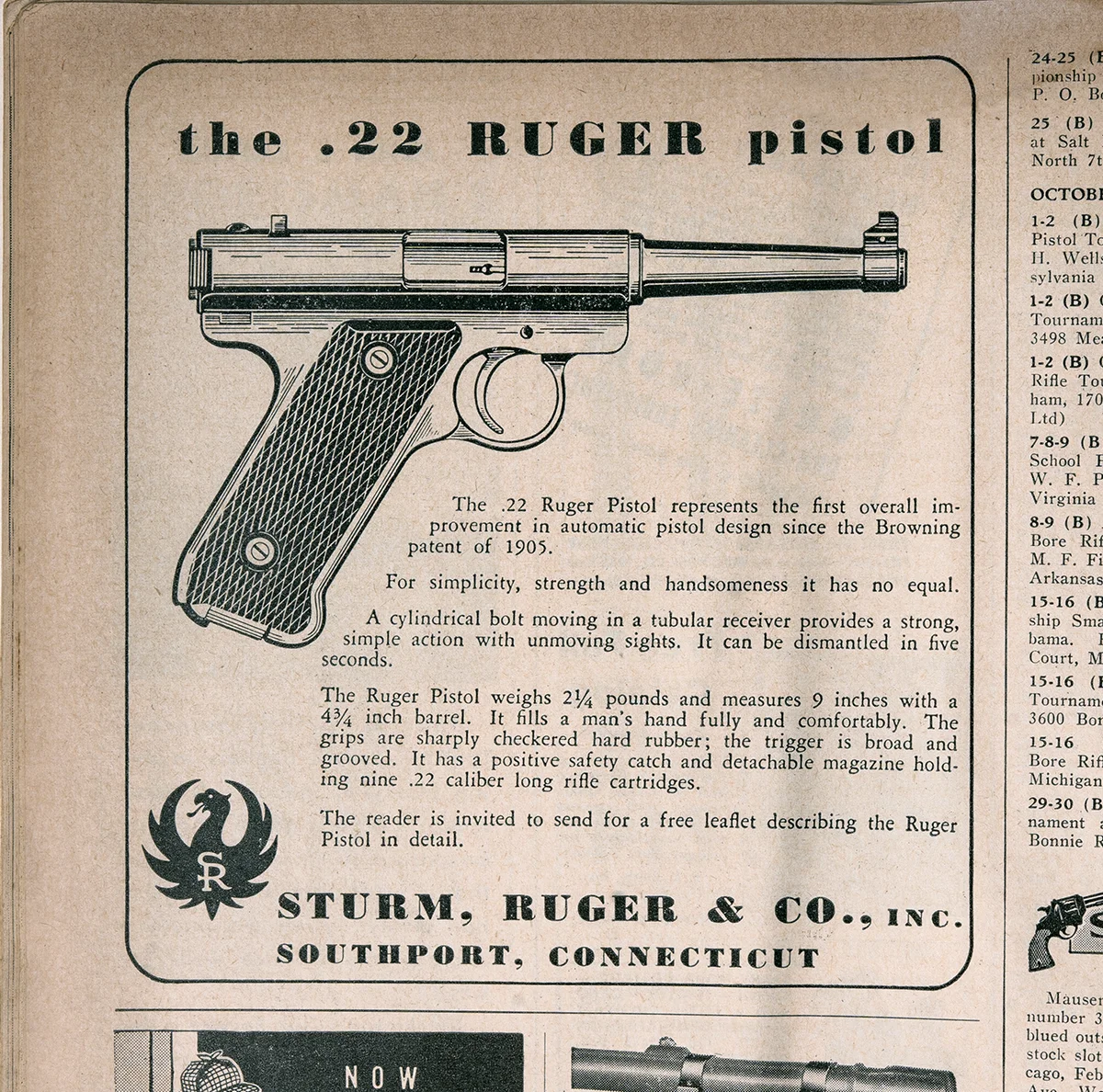
In the August 1949 issue of American Rifleman, Ruger placed his first ad for the pistol. Three months later, the same magazine contained an enthusiastic review from none other than Major General Julian Hatcher – one of the best-known firearms experts of the 20th century.
That endorsement, combined with the $37.50 price tag, was enough to overcome any doubts that readers may have had about the unknown company. Ruger shipped 1100 pistols by the end of 1949, and demand remained so high that it was on constant backorder until the 1970s.
Overview of Models
Ruger has made dozens of variants of the Mark series over the years, but they’re generally broken down into four distinct generations, each with some key changes. I won’t go too deep into all the internal differences, but I’ll try to cover the major features that define each generation.
Standard & Mark I (1949-1982)
The first generation started with what was originally called the “Ruger .22 pistol.” They started calling it the Ruger Standard in 1950 to distinguish it from a new target version called the Mark I.
The Standard we have here is from 1979, making it a late first generation pistol. Ruger made a few minor production changes in those first few decades, but this is functionally the same as the original pistols they shipped out in 1949.
The Standard came with either a 4 ¾-inch barrel like this one or a 6-inch barrel. It has fixed iron sights, with the rear sight drift-adjustable for windage. The grips are a checkered hard black nylon material with the Ruger logo embedded on one side. Factory walnut grips could be purchased separately. It has a nice blued finish. With very few exceptions for some limited run pistols, all of the first gen guns were blued.
The Mark I target pistol was developed with some input from Jack Boudreau, a Ruger employee and competition shooter who had customized his Ruger Standard. It had a 6 ⅞-inch heavy barrel, fully adjustable target sights, and an improved trigger.
The original cost of the Mark I was $57.50 – $20 more than the Standard. Despite struggling to meet demand, Ruger did not raise the price of either pistol until the mid 1960s. Around that same time, they also introduced the Mark I bull barrel models.
Early Design Features
Rather than a conventional slide, the pistol has a steel tube receiver that holds a spring-loaded bolt. The bolt is really the only thing that moves when the pistol cycles. This was a big selling point at the time because, unlike other .22 pistols, the sights were always stationary. Whether that’s a noticeable benefit for the average shooter is debatable, but it’s something they always used to mention in reviews.
All of the first generation pistols have the magazine release in the heel of the grip—a feature that carried through until the Mark III. The original magazine capacity was only 9 rounds.
The early Rugers also lacked a bolt hold-open on the last round. You could lock it open manually by holding it to the rear and then engaging the manual safety on the left side of the frame. If you engage the safety with the bolt closed, then it locks in the closed position.
For 33 years, Ruger stuck with this basic design, producing over a million first-gen pistols. The design was simple and affordable, but highly functional. It was considered very accurate and reliable. It’s no surprise that it became the go-to rimfire pistol for many American shooters.
Mark II & Mark II 22/45 (1982-2005)
In 1982, Ruger introduced the Mark II. This is when they switched to the naming convention we know today. All of the second gen pistols fall under the name Mark II. So the Standard became the Mark II Standard and the Mark I became the Mark II Target.
The Mark II pistols finally featured a bolt-hold-open on the last round, with a bolt-stop or bolt-release latch above the left grip panel. They also redesigned the magazine and upped the capacity to 10 rounds. Almost every variant of the Mark II was available in stainless steel in addition to the original blued finish.
In 1992, Ruger added the 22/45 to the Mark II lineup. This was a major departure from all previous models. It had a lightweight polymer frame with a mag release button on the left side and a grip to match the feel and angle of a Colt 1911. It was meant as a training pistol for 1911 shooters, and today, the 22/45 variants are at least as popular as the traditional steel-framed models.
Mark III & Mark III 22/45 (2004-2016)
The Mark III launched in 2004 and it was not quite as well-received as the Mark II. Ruger added a few safety features that no one was really asking for. First was a magazine disconnect safety, which they’ve carried over to the Mark IV. There was a big, gaudy chamber indicator on the left side of the receiver. And they added an internal key-activated safety lock.
There was one change that most shooters seemed to appreciate. The mag release on the steel frame models was relocated from the heel of the grip to a button on the left side of the frame like the 22/45.
Most Mark III pistols were drilled and tapped at the factory for a scope mount. Early on, this was only done to the Target models, but at some point, Ruger extended the treatment to all Mark III variants.
The Mark III 22/45 was totally recontoured for this generation. The grip more closely resembled 1911 grip panels. For later production Mark IIIs, Ruger got rid of the molded-in grips completely in favor of removable grip panels.
Mark IV & Mark IV 22/45 (2016-Present)
In 2016, Ruger made the most dramatic design changes to the pistol with the release of the Mark IV series. The biggest change here was the takedown process. One of the common complaints about the earlier models was how difficult they were to disassemble and reassemble for cleaning.
Now, to be fair, it’s really not that bad when you compare it to other guns designed in the 1940s. In fact, in Hatcher’s 1949 review, he called the takedown “quick and easy.” But it does require multiple tools, and it’s a cumbersome process if you’re used to just rotating a latch to pop the slide off of your more modern pistols.
The Mark IV changed that completely. With a single button press on the back of the frame, the upper receiver hinges forward and comes right off and the bolt slides out the back. Reverse the process to put it back together. It could not be any easier.
Another improvement was the complete redesign of the manual safety. The new safety is ambidextrous, although it’s easy enough to remove the right side lever if you prefer. It’s more of a shelf-style thumb safety like a 1911 as opposed to the sliding button-type lever from the earlier models.
Ruger also got rid of the loaded chamber indicator and the internal lock with this generation. And a lot of the internals were redesigned like the trigger group and the bolt stop.
Why We Love the Mark Series
I don’t know if it’s fair to call the Ruger the best .22 pistol of all time. That’s kind of subjective. But if we look at longevity, number of units sold, versatility, or sustained popularity over time, nothing else comes close to the Mark series. So how did Ruger pull this off?
Performance on a Budget
Well, for starters, it’s just a very clever design. There’s nothing mechanically novel about it. It was more or less a combination of existing designs. Bill Ruger’s genius was in making it cheap to produce while retaining most of the qualities shooters wanted. It also helped that Ruger was an avid shooter himself, so he was essentially building the kind of .22 pistol that he wanted in his own collection.
Most of Ruger’s products throughout the history of the company have followed this same pattern. They take a basic design for a product category that has existing demand. They figure out how to make it cheap, but still functional. With the Ruger Standard, that was largely achieved by using stamped sheet steel, but later products relied heavily on cast parts, rather than more expensive machined parts.
During those first few decades, High-Standard, Colt, and other companies tried lowering their prices. They came up with their own lower-cost models to try to compete with Ruger. But for the most part, they never quite offered the same value. No one else could ever seem to nail that combination of accurate, reliable, and affordable.
Versatility
Today’s .22 pistol market is quite a bit different. We have a whole lot more options available and many of them are accurate, reliable, and affordable, and they’re not all Rugers. But Ruger has managed to stay on top. That’s at least partly due to momentum, but that only gets you so far.
I think what’s kept these guns relevant, especially in the last 10 or 15 years, is that Ruger has done a pretty good job of just paying attention to what shooters actually want.
Modern gun owners are spoiled for choice and we can be a very particular bunch, to put it mildly. Ruger’s response has been to make something for everybody. They currently have 23 different Mark IV variants on their website – 43 if you count all of the distributor exclusive models. They’ve added a bunch of threaded barrel options as suppressors become more common. I am partial to the Mark IV Lite, which has a lightweight aluminum upper receiver.
Of course, even with all of these factory options, we are going to find things we want to change about these guns. That’s where the other big strength of the Mark series comes in: customizability. You can buy or assemble a Ruger Mark III or Mark IV-pattern pistol with zero Ruger-made parts in it. The two best-known suppliers are Volquartsen and TandemKross. They both make parts as well as complete pistols. I believe they’re the only two making their own Ruger-compatible frames, but lots of other companies make barreled uppers and internal parts.
Most of these aftermarket options are geared toward improving accuracy or speed, but really, you can get parts to make your Ruger better at just about anything you’d want a rimfire pistol to do.
A Mark IV for Everyone
Okay, now I know you’re just dying to find what I’ve got on my beginner-friendly Mark IV. I chose this 2.5-inch barreled upper from MaddMacs Precision because it’s not only short, it also has an extra-low optic mount. My buddy Mike at Gideon Optics sent me this Omega green dot sight to try out. It’s turned out to be ideal for this application. The window is huge, and it fits on a standard RMR mount.
I’ve got my Silencerco Sparrow on the front. I added a TandemKross charging ring to the bolt to make it super easy for anyone to rack.
The lower is just a vanilla 22/45 frame with a Volquartsen trigger kit to lighten the trigger pull – but not too much. It’s not a gamer gun. And I got a set of checkered walnut grip panels, mostly because I thought they looked neat. But also, I think a little wood on a gun can be less intimidating than all-black for some first-time shooters. It makes it look like something their grandpa might have owned.
There are a ton of really great .22s on the market today and many of them are as good or better than the Rugers in certain respects. But it’s hard to beat the Mark series for sheer versatility. Just like the original Ruger Standard, today’s Mark IV is still the best “Jack of all trades” rimfire pistol you can buy.
